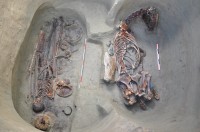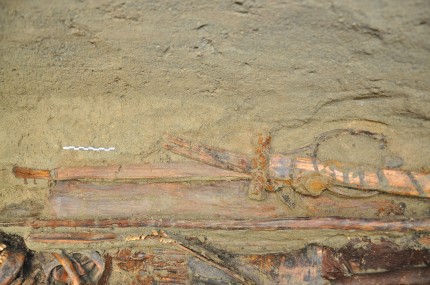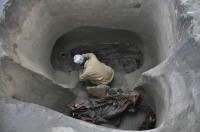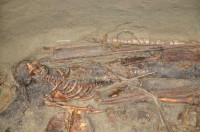 Archaeologists have found an artifact they believe to be an ancient musical instrument in the burial of a Turkic warrior in the region of East Kazakhstan. The burial in the Altai mountains was found intact, with the remains of an adult male in his 40s at the time of death and those of a horse buried next to him. The grave goods identify the deceased as a warrior of some status, and their design allowed archaeologists to provisionally date the burial to the 7th century.
Archaeologists have found an artifact they believe to be an ancient musical instrument in the burial of a Turkic warrior in the region of East Kazakhstan. The burial in the Altai mountains was found intact, with the remains of an adult male in his 40s at the time of death and those of a horse buried next to him. The grave goods identify the deceased as a warrior of some status, and their design allowed archaeologists to provisionally date the burial to the 7th century.
The scientists found weapons belonging to this epoch next to the warrior: a helmet, a quiver, an arrow, a sword, sabers, as well as a horse with a golden harness and a bridle. The most important discovery of the excavation was a musical instrument, similar to (Kazakh) kobyz….
The kobyz is an ancient Kazakh instrument that has two strings made of horsehair. It was believed to be a sacred instruments that could drive away evil spirits. It was often used by spiritual medics and shamans.

There has been a dedicated effort by the Kazakh government and institutions of higher learning to expand historical and archaeological explorations of the nation’s past. The Altai mountains have been the site some of the most important archaeological finds relating to the nomadic peoples who inhabited the region from the 1st millennium B.C. on.
 This most recent find was made as part of a Turkic Academy project investigating the statehood system of Western Turkic Khaganate, a state ruled by a Khagan (or Khan) of the Ashina clan after the founder’s kingdom, the Göktürk Khaganate, was split into east and west by his sons in the early 7th century. At its peak, the Khaganate’s sphere of influence stretched from the Caspian Sea in the west to the Sea of Okhotsk in the east, from modern-day Kazakhstan all the way to the other side of Russia. Its founder, Bumin Khagan, was crowned in the Altai mountains, so this was an important center of power.
This most recent find was made as part of a Turkic Academy project investigating the statehood system of Western Turkic Khaganate, a state ruled by a Khagan (or Khan) of the Ashina clan after the founder’s kingdom, the Göktürk Khaganate, was split into east and west by his sons in the early 7th century. At its peak, the Khaganate’s sphere of influence stretched from the Caspian Sea in the west to the Sea of Okhotsk in the east, from modern-day Kazakhstan all the way to the other side of Russia. Its founder, Bumin Khagan, was crowned in the Altai mountains, so this was an important center of power.
 The Khaganate united a great many nomadic tribes under one (or after the splintering, two) rulers. In the second half of the 7th century, the ten tribes of the Western Turkic Khaganate began to fight amongst themselves which left the state vulnerable to Chinese invasion. In 659 A.D., it was absorbed into Tang Dynasty China. They didn’t get to keep it for long. The tribes revolted and in 682 A.D., the Second Turkic Khaganate was established. It was the first Central Asian state that used Old Turkic as its official language, as evidenced by its appearance on stele known as the Orkhon inscriptions that tell the history of the Khaganate and its liberation from Chinese rule.
The Khaganate united a great many nomadic tribes under one (or after the splintering, two) rulers. In the second half of the 7th century, the ten tribes of the Western Turkic Khaganate began to fight amongst themselves which left the state vulnerable to Chinese invasion. In 659 A.D., it was absorbed into Tang Dynasty China. They didn’t get to keep it for long. The tribes revolted and in 682 A.D., the Second Turkic Khaganate was established. It was the first Central Asian state that used Old Turkic as its official language, as evidenced by its appearance on stele known as the Orkhon inscriptions that tell the history of the Khaganate and its liberation from Chinese rule.
The remains of the Altai warrior will be removed for further investigation by the Turkic Academy. The bones will be directly dated and the surviving organic elements like the wooden musical instrument conserved and studied.